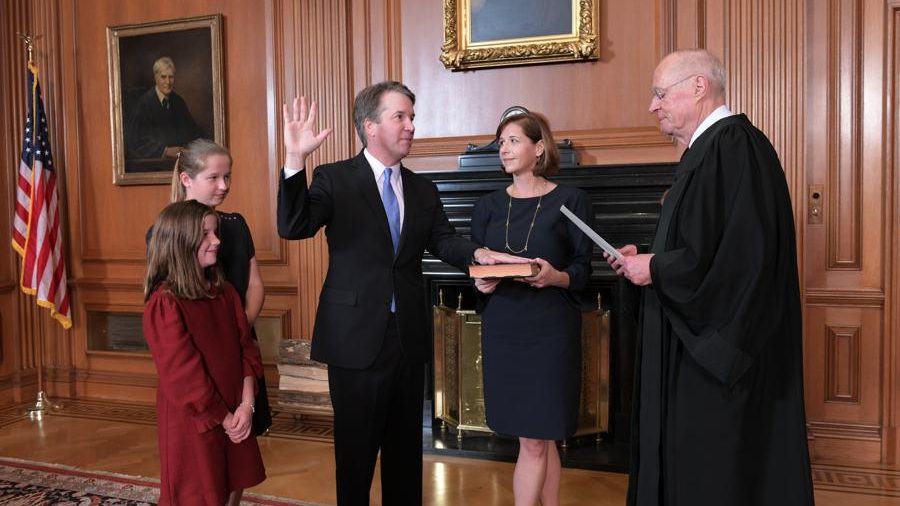How Faith and a Treehouse Played Into Unlikely Confirmation of Justice Brett Kavanaugh
Seeing two Justices confirmed to the Supreme Court has been President Trump’s biggest win. Small moments behind-the-scenes reveal how Brett Kavanaugh made it through the process.

Retired Justice Anthony M. Kennedy, right, administers the Judicial Oath to Judge Brett Kavanaugh in the Justices' Conference Room of the Supreme Court Building. Ashley Kavanaugh holds the Bible. At left are their daughters, Margaret, background, and Liza.
Their book is currently topping the best-seller charts on Amazon and other rankings… despite the New York Times trying to keep its success hidden.
In an exclusive Stream excerpt from Justice On Trial, Mollie Hemingway and Carrie Severino share key moments from the confirmation process of Brett Kavanaugh. He was confirmed to the Supreme Court on October 6, 2018.
Saturday night, July 7, was a dark moment for the Kavanaugh team. It appeared that Majority Leader Mitch McConnell was opposed, White House counsel Don McGahn had lost faith, and President Trump was desperate to find another candidate.
Gathered in the hot conference room, empty pizza boxes piled high, the team started coming to terms with their likely loss. Roman Martinez told stories about his time working for the U.S. government in postwar Iraq, finding parallels with the high-stakes political fights there.
Later that night, Brett Kavanaugh sent them an email encouraging them to act with dignity and remain calm no matter how the process ended, a sure sign that no one thought he would win the nomination.
But they had to keep working.
Preparing a First Impression
The White House was constantly asking for information, including lists of people who would be invited to a nomination announcement if Kavanaugh were selected.
They had to prepare a speech for that event, however unlikely it now seemed, and Kavanaugh, who had taught a class at Harvard on the Supreme Court, knew it would be important.
It would be his only chance to make a first impression on most of the country. And it would be his only public remarks before the confirmation hearings eight weeks later, an interval when the opposition could be counted on to raise a deafening howl. Chris Michel, a former Bush speechwriter who had also clerked for Kavanaugh, was helping with the speech.
The judge himself was an experienced wordsmith, having worked on presidential speeches from the State of the Union on down, but his first draft clocked in at thirty-seven minutes, far longer than the five minutes that would be appropriate. “We’ve got to go long before we can go short,” he joked.
Sunday arrived, and Trump called Leonard Leo again asking for his thoughts on Kavanaugh. Leo suggested that he meet with Kavanaugh again if he was so uncertain.
My Grace is Sufficient
Kavanaugh, a regular churchgoer, served as a lector at Blessed Sacrament parish in Chevy Chase every eight weeks. As Providence would have it, his turn was up again, and he was struck by the passage he would read that evening.
It was from St. Paul’s Second Epistle to the Corinthians:
Therefore, that I might not become too elated, a thorn in the flesh was given to me, an angel of Satan, to beat me, to keep me from being too elated. Three times I begged the Lord about this, that it might leave me, but he said to me, “My grace is sufficient for you, for power is made perfect in weakness.”
The passage continues:
I will rather boast most gladly of my weaknesses, in order that the power of Christ may dwell with me. Therefore, I am content with weaknesses, insults, hardships, persecutions, and constraints, for the sake of Christ; for when I am weak, then I am strong.
He thought the reading was so comforting that he shared it with his clerks. As affecting as he found the apostle’s words at that stressful moment, he could little imagine how apropos they would be in the coming months.
On his way to church for the 5:30 Mass, Kavanaugh got a call asking if he could meet with the president again at seven o’clock that evening. He was wearing a coat and tie but not a suit.
A Treehouse to Foil the Press
His wife Ashley was just getting home from a lacrosse tournament with the girls. He called her to see if she could bring a suit to church and stick it in the car driven by his security detail. She met the car in the parking lot, rolled up the suit so it wasn’t obvious what she was carrying, and made the transfer.
The marshals had told Ashley to clear herself and the girls out of the house. Whether or not her husband was chosen, the cameras already set up across the street would be following the family’s every movement, looking for clues about the nomination.
So they packed their bags and left the home by a hidden passageway connecting their yard and the neighbors’, undetected by the press across the street. To hide their escape plans, they stashed their luggage in a neighbor’s tree house and asked a neighbor girl to retrieve it for them later. Then they went out to dinner as normally as possible.
Afterwards, they made sure they weren’t being followed. Instead of returning home, they drove to the house of close friends who were vacationing on Martha’s Vineyard.
Mollie Hemingway is senior editor of The Federalist, and Carrie Severino serves as chief counsel and policy director of Judicial Crisis Network. Their new book Justice on Trial is available now.







